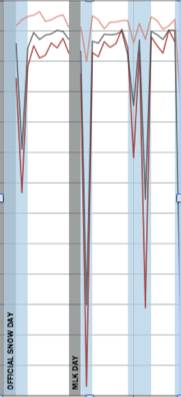Every winter, snow and slushy weather keep parents from getting their children to school. So do the colds, fevers and earaches that often come with the winter months.
These absences, even if they are excused, can add up to academic trouble. Attendance Works has developed a toolkit with talking points, handouts, sample letters and robocalls that schools can use to combat winter weather absences.
A study of in Massachusetts, Flaking Out: Student Absences and Snow Days as Disruptions of Instructional Time, found that each missed day affected a student’s test scores and grades. Interestingly, the researcher did not find the same impact when the entire school was shut down for heavy snow. Rather, it was on days with moderate snow, when school stayed open but some students missed class, that the effects were seen.
The impact of weather-related absences was twice as large for students from low-income families as it was for their more affluent peers, the study found. Black and Hispanic students were also disproportionately affected.
Researchers at the Center for New York City Schools at the New School tracked absenteeism rates on a fever chart and found significant dips on snowy days when school was in session, shown in pale blue on the chart to the right. The steepest drop came in a school in a low-income neighborhood, the dark red line on the chart, part of the new study A Better Picture of Poverty: What Chronic Absenteeism and Risk Load Reveal About NYC’s Lowest-Income Elementary Schools
These trends underscore two factors that often influence attendance: transportation and health. Low-income students are more likely to depend on public transit or walking to get to school, both of which can be easily disrupted in a snowstorm. These same students are less likely to have access to good health care, making them more susceptible to colds and other ailments.
So what can parents do?
First, they can develop back up plans for getting children to school in winter weather. That could mean checking with other parents who have a car that can manage in the snow or forming a “walking school bus” to walk children to school with other parents. The school’s front office can help, too.
Parents can also do their best to keep children healthy by dressing them warmly for the cold weather and encouraging them to wash their hands regularly. A study showed that regular use of hand sanitizer can help reduce absences. If children do get sick, parents should talk to a doctor or the school nurse about whether they should come to school. This handout offers some tips about when children are too sick for school.